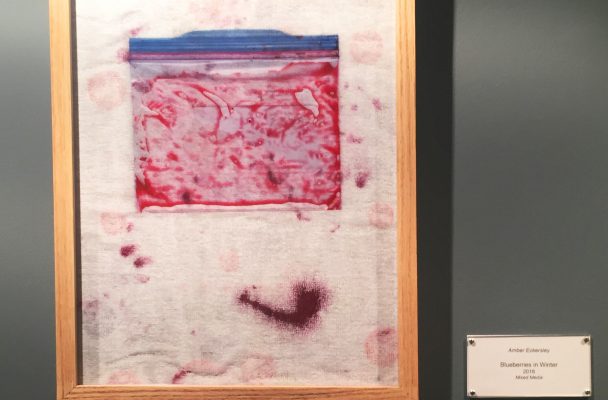Come to ‘Food for Thought’ hungry for great art

Amber Eckersley’s “Blueberries in Winter” features a scan of a plastic bag that was used to store frozen blueberries. Photo By: Liz Reichart
By Jenn Zeleski//Staff Writer
The small sign on the wall outside of the Darrell E. Seacrest Art Gallery may inform visitors that all food and drinks are not allowed, but it could not be more contrary to the new pieces being featured in the fifth annual Visions 2017 Food For Thought exhibition open now through March 2. February’s topic for the exhibit focuses on the culture of food, embracing the depth of a subject that is so simple yet so significant to all of us.
“There is hardly a facet of our lives where food is not more than mere sustenance and pleasure,” said Greg Shelnutt, curator of the exhibit from Clemson University. “It’s an important topic and I hope that in some small way, this exhibition contributes to that on-going dialogue.”
Each artist brought their unique perception to every piece, offering a culturally contrasting yet cohesive exhibit for viewers to relate to, especially if their stomachs are growling.
Shelnutt explained that art encompassing the idea of food can be used in a variety of ways, especially to express the various meanings behind the artist’s message.
“Art can use humor such as Robbie Barber’s castings, be a product of the literal residue from a meal, as with Adrienne Lichliter’s lithographs, or quietly explore the beauty of a simple Southern staple like collards—a kind of nostalgia and an evocative sense of “home”—as does Amber Eckersley’s scans of collard leaves on gold leaf,” Shelnutt said.
Margi Weir placed first for her piece “Fringe Fries,” an adhesive vinyl piece with patterns of identifiable images.
“The work of art draws the viewer into a slowly unfurling narrative that invites a discussion about ecology and/or sociopolitical realities of the world around us,” Weir said.
The piece varies in meaning when it’s considered as different parts versus when it’s considered as a whole, which inspires viewers to consider the on-going dialogue as Shelnutt mentioned.
“A gallery is not a church or a library—it’s okay to talk and share ideas, take notes and to sketch,” Shelnutt said.
Most of the pieces would inspire visitors to do just that. Daphne Cuadrado, who placed second for her entry “100 Reasons,” encompassed part of the entire gallery with 100 small blue bowls of water, each with a various “reason” floating within. It begs the question of how we can adapt our own perceptions of food, food culture and its impact into a variety of intriguing ways.
In third place was Amber Eckersley, with her piece “Collard Leaves on Gold Fabric,” who thoughtfully disclosed in her artist’s statement a cultural meaning that may seem simple to some, but foreign to others.
“There is a physical weight to these leaves as well as a cultural weight,” Eckersley said. “The history of cooking collard greens, particularly in the American South, is a tradition passed down through generations of families. This work makes it difficult to overlook the significance of this lowly leaf.”
Through this connection, Eckersley allows viewers to be exposed not only to the physical aspects of her visual work, but also the personal and intimate ties to the meaning behind it.
Regardless of what food you love or hate, everyone can get something out of merely observing the literal and figurative meanings behind art with an appetizing theme. As time goes on, our relationships and knowledge about food will evolve.
“Food has become such an important issue in our society today,” Shelnutt said. “From food allergies to genetic modifications and non-GMO foods, to how we allow access to and pay field laborers, to farm-to-table restaurants, to the proliferation of food-related television, to how we address the issues of hunger and malnourishment for at-risk populations.”
These topics and issues can only stem into bigger conversations about food and how it impacts each and every one of our lives.
Although the new exhibit may not be the new place to grab a quick bite on campus, a visit will provoke some much-needed dialogue about food in a variety of ways some may not consider on a normal basis. Instead of sipping a smoothie or picking at cold tater tots, Shelnutt suggests students, faculty and staff experience the art gallery for themselves.
“Food will only become a more and more important topic in the years to come,” Shelnutt said. “Of course, artists will continue to explore these ideas, and I look forward to seeing what comes next.”